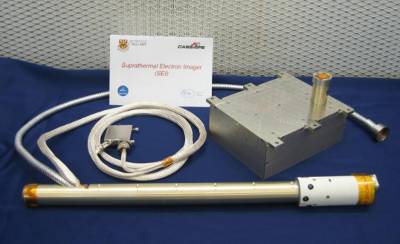
The SEI sensor head, boom, and electronics unit
The e-POP Suprathermal Electron Imager (SEI) measures the electron energy and pitch angle distribution over the energy range of 1 to 200 eV, with particular emphasis on photoelectrons in the 1 to 50 eV range, which are believed to play an important role in the polar wind outflow.
SEI is a 2-D electrostatic analyzer/imager consisting of a 2.5-cm diameter cylindrical sensor head. The sensor is mounted on an 80-cm boom to place it outside the spacecraft sheath. Its skin bias is adjustable in its thermal mode to counteract the spacecraft potential and to control the input particle flux.
The e-POP/SEI is an improved version of the GEODESIC/TEI instrument. Incident electrons traverse the electrostatic hemispherical analyzer and are dispersed according to their energy and azimuth across the MCP detector. The energy range detected is dependent upon the sensor skin bias and the internal analyzer bias voltage.
SEI has field of view of ±15° in elevation and 360° in azimuth. Its entrance aperture plane is within 15° of the local magnetic field at high latitude.
SEI employs a 256 x 256-element CCD detector, which is optically coupled to the electronics unit and de-coupled from the sensor bias voltages. It uses an MCP to amplify the incident electron azimuth/energy distribution and image it onto a phosphor screen that is fibre-optically coupled to the CCD sensor. It is capable of operating at an imaging rate of 100 Hz.
SEI was developed, built and tested at the University of Calgary under the direction of Dr. David Knudsen.
